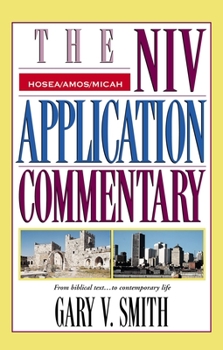Hosea, Amos, Micah
(Part of the NIV Application Commentary, Old Testament Series)
Select Format
Select Condition 
Book Overview
The NIV Application Commentary helps you communicate and apply biblical text effectively in today's context. To bring the ancient messages of the Bible into today's world, each passage is treated in three sections:
Format:Hardcover
Language:English
ISBN:0310206146
ISBN13:9780310206149
Release Date:March 2001
Publisher:Zondervan Academic
Length:608 Pages
Weight:2.20 lbs.
Dimensions:1.2" x 6.3" x 9.5"
Age Range:18 years and up
Customer Reviews
2 ratings
A Preacher's goldmine for preachin' and teachin'.
Published by Thriftbooks.com User , 16 years ago
Although I don't often get excited about a NIVAC commentary, this one is really good. I'm preaching through Micah right now. I've had people tell me recently that they have never heard a sermon series through Micah. In a day when few believers hear sermon series through important Old Testament books like Micah, it's critical that we do not get bogged down in simply what the text meant to Israel 2800 years ago, but that we move on to relevant and life transforming truths for today. For details on this, let's zoom into Gary Smith's section on Micah 3. Micah 3 contains condemning prophecies about the leadership of Israel. In these 12 verses of chapter 3 Smith offers up 16 and a half pages of commentary. His commentary (as is the pattern in the NIVAC series) sports an initial section called 'Original meaning'. This is his exegetical section. Compared to other commentaries it is the same basic pattern except that this one is easy to read. A major and refreshing change is that this series avoids technical language issues...like transliterations of the Hebrew and detailed discussions about whether or not Micah wrote a phrase or verse here or there...and all the theories about source material. He even avoids the grammatical analysis that some commentaries really shine on. So for a technical commentary that a student or scholar would prefer, "this ain't it". But if you are teaching through Hosea, Micah or Amos, this is a great tool! So, after two pages of an overview of the basic meaning of this chapter, he then gives a mini view of each of the three paragraphs within this chapter. In his overview he talks about the unity of their judgment themes AND the progression of the judgment as the prophecy unfolds. He does link Hezekiah's repentance in Jeremiah 26 to Micah (which I find very plausible). In 3:1-4 we have graphic illustrations that are meant to shock the reader. The idea of 'Cannibalism' by the leaders is probably a metaphor designed to show the beast-like behavior of the leaders from God's perspective. Smith essentially says this in a memorable and preach-able fashion (his summary is far better than the other commentators I've read so far on this chapter-even though he does not get into the Hebrew text or quote Hebrew grammatical points and all of the questions about textual variations that can consume some exegetical commentaries). After this very helpful section, Smith moves on to 'Bridging Contexts' where he discusses related passages and themes. In this section there are many ideas that could really help a preacher. As he talks about justice and judicial leaders and political leaders, there are several illustrations from the Old Testament that Smith ties this particular passage to. For this paragraph he links to specific instances of David and Nehemiah that bring in illustrations that not only preach well, but also give the preacher great ways to further educate the congregation on how God's word has cohesive themes. He co
Clear, straightforward, solid exposition.
Published by Thriftbooks.com User , 21 years ago
This is the most practical, easy to understand commentary on these minor prophets available. A must have for your biblical library. I also suggest you get a copy of Dr. Smith's commentary "Amos" and his book "The Prophets as Preachers". Your understanding of the messages from the prophets will be greatly enhanced by a study of Dr. Smith's works.





